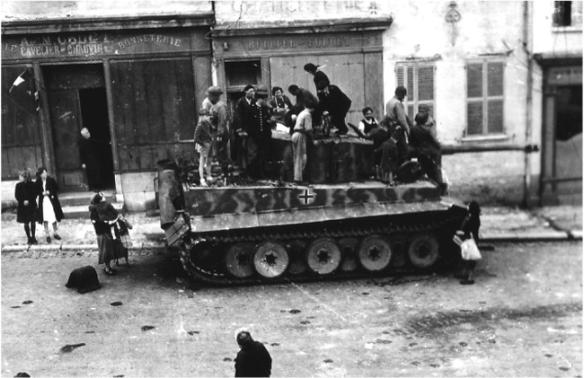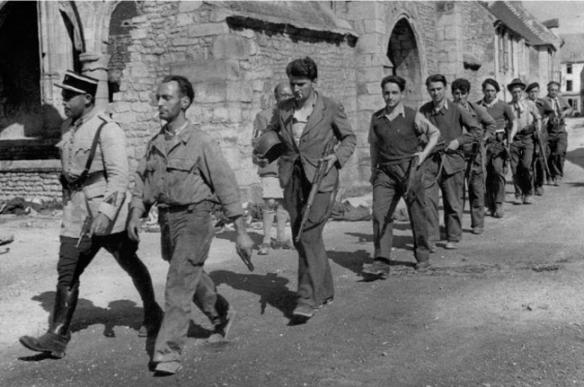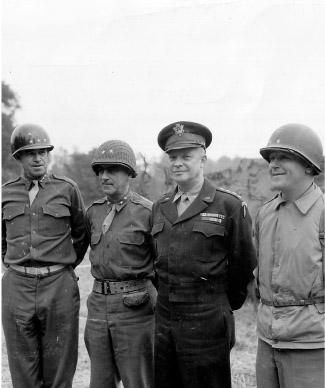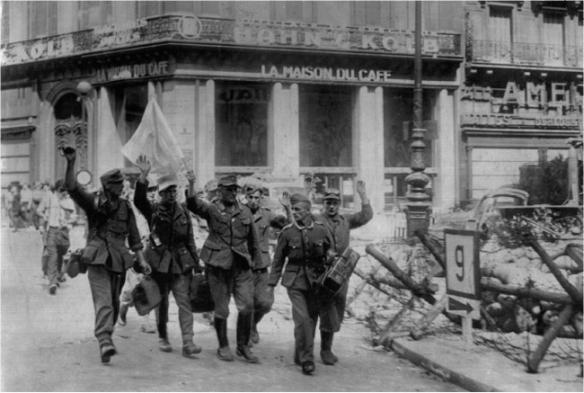Plates

Commander-in-Chief West Generalfeldmarschall von Rundstedt confers with SS-Standartenführer Kurt Meyer, commander SS-Panzergrenadier Regiment 25. The 12th SS Panzer Division’s commander, SS-Brigadeführer Fritz Witt, stands in the centre. After he killed on 14 June 1944 Meyer assumed command. (via Author)

Generalfeldmarschall Erwin Rommel, commander Army Group B, wanted the Panzers within striking distance of the coast, this lead to friction with Rundstedt and General von Schweppenburg, commander Panzergruppe West. (via Author)

A relaxed looking SS-Obergruppenführer Josef ‘Sepp’ Dietrich, commander I SS Panzer Corps, which formed part of Panzergruppe West. He succeeded General Heinrich Eberbach as commander Panzergruppe West/5th Panzer Army in early August 1944. (Author’s collection)

SS-Obersturmführer Michael Wittmann, commander II Kompanie, Schwere SS-Panzer Abteilung 101. His prompt action at Villers-Bocage on 13 June 1944 saved the Panzer Lehr Division from encirclement, prevented the German line from being rolled up and stopped the Allies breaking out to the southwest of Caen. (via Author)

General Walter Krüger, commander LVIII Panzer Corps meeting men of Panzer Lehr. His Corps formed the southern flank of the counterattack near Avranches with elements of Panzer Lehr and the 17th SS in early August 1944. (ECP Armées)

Generalleutenant Dietrich von Choltitz replaced General Marcks, killed on 12 June, as commander LXXXIV Corps. Rundstedt’s verdict of him was ‘decent but stupid.’ Choltitz’s poor handling of Panzer Lehr and his corps saw him lose his command and gain the poison chalice of military governor of Paris. (US Army Archives)

General Otto Elfeldt, von Choltitz’s successor as commander of LXXXIV Corps, was captured near Hill 113 on 20 August 1944 by the Polish 1st Armoured division. He had the dubious honour of being the most senior officer taken during the fighting to seal the Falaise pocket. (USAA)

Panzergruppe West’s major advantage was the qualitative edge of its panzers. The most common type in Normandy was the PzKpfw IVAusf H and J, with frontal armour of 80mm and a 7.5cm KwK 40 L/48 anti-tank gun. This provided the backbone of the German panzer divisions. (USAA)

American Military Police escort US P-47 Thunderbolt pilots to examine their handiwork on 19 July 1944. The PzKpfw V or Panther represented the pinnacle of German tank production, mounting the powerful 7.5cm KwK 42 L/70 gun that could penetrate 120mm of armour at 1,094 yards. The main models deployed in Normandy were the Ausf A and G. (USAA)

French villagers get a closer look at an abandoned Tiger. While the PzKpfw VI Tiger I was a formidable weapon with 100mm frontal armour and 8.8cm KwK L/56 gun, only three battalions were deployed in Normandy. (USAA)

Captured teenage SS-panzer grenadiers, the 9th SS, 10th SS and 12th SS deployed youngsters such as these. What they lacked in experience they made up for with fanaticism. (USAA)

Another common armoured fighting vehicle with the panzer divisions in Normandy was the Sturmgeschütz or StuG III assault gun armed with the 7.5cm StuK40 L/48. (USAA)

The main self-propelled antitank weapon was the Marder armed with a 7.5cm PaK 40/3. This particular example lies shattered after an encounter with the American Army. (USAA)

The principal self-propelled artillery in Normandy comprised the Wespe, seen here, based on the Panzer II armed with a 10.5cm gun and the Hummel self-propelled 15cm howitzer, mounted on the Panzer IV chassis. (USAA)

French civilians trudge past a knocked out Sdkfz 135 7.5cm Pak 40/1 auf Lorraine Schlepper, probably from Major Alfred Becker’s Sturmgeschütz Abteilung 200, 21st Panzer. The Germans deployed a range of hybrid self-propelled guns based on French tank and ammunition tractor chassis. (USAA)

Dead panzer grenadiers lay strewn by their camouflaged SdKfz 251 armoured personnel carrier, which were used to equip the panzergrenadier regiments. (USAA)

By far the best tank killer was the dedicated 8.8cm Pak 43, the antitank version of the 8.8cm Flak 36. These helped take a very heavy toll on British armour during the Goodwood offensive. (Author’s collection)

Rows of 7.5cm Pak 40 anti-tank guns; the Germans had this weapon in abundance in Normandy. (USAA)

The most common Allied tank in Normandy was the American M4 Sherman. Mechanically reliable, it was handicapped by thin armour, a gun lacking sufficient punch and a tendency to burn. (USAA)

The French Maquis played a key role harassing German troop movements and gathering intelligence. Most notably the 2nd SS fought running battles with them as it moved north to Normandy. (Author’s collection)

The Americans developed tank destroyers based on the Sherman that could penetrate at least 80mm of armour at 1,000 yards, notably the M10 Wolverine armed with a 3-inch gun, though these were not available in sufficient quantities. (USAA)

The prelude to D-Day saw the Allied bomber fleets attacking railways and the bridges over the Seine to prevent reinforcements moving up and to hamper escape. (USAA)

While the German armed forces were largely able to ride out Allied air attacks, they greatly underestimated naval gunfire. This hampered the panzers’ efforts to counterattack in the Caen area following D-Day. (USAA)

Although Canadian armour pushed through to Carpiquet airfield on 8 June 1944 the 12th SS stopped them in their tracks, destroying a total of twenty-seven tanks for the loss of fourteen panzers. (USAA)

The American architects of the southern flank of the Falaise salient: Generals Bradley, Gerow, Eisenhower and Collins. Bradley’s decision to halt the US XV Corps at Argentan partly ensured Falaise was a flawed victory. (USAA)

Sturmgeschütz of SS-Panzer Abteilung 17, 17th SS Panzergrenadier Division, got to within 500 yards of Carentan before being stopped by elements of the US 2nd Armored and 101st Airborne Divisions on 13 June 1944. (USAA)

German armour caught in the Roncey pocket – these abandoned Marder self-propelled guns belong to the 17th SS Panzergrenadier Division or the 2nd SS Panzer Division. (USAA)

American armour pours into Avranches five days after the launch of Operation Cobra, this opened the way for the swing west into Brittany and east toward the Seine. (USAA)

Following the Mortain counter-attack XLVII Panzer Corps was no match for the US XV Corps’ French 2nd Armoured Division, seen massing here, and the US 5th Armored Division. (USAA)

By 10 August strong American forces including the US 5th Armored Division, seen here, had successfully pivoted from Le Mans northwards, striking toward Alençon, which fell two days later. (Author’s collection)

Officers and men of the 2nd Panzer Division surrender to the Canadian Army on 19 August in St Lambert-sur-Dives. During the bitter two-day battle for the village the Germans suffered 300 dead, 500 wounded and 2,100 captured. (USAA)

US troops stream into Argentan on 20 August. Its capture helped seal the fate of those German forces still inside the Falaise pocket. (USAA)

The shattered remains of an army – the end of the road for many Germans in the Falaise pocket. During this final battle the Wehrmacht lost approximately 10,000 killed and 50,000 captured, though they claimed 40,000 escaped. (USAA)

Eisenhower during his tour of the Falaise pocket examines an over turned Tiger II. He recalled: ‘Forty-eight hours after the closing of the gap I was conducted through it on foot, to encounter scenes that could be described only by Dante’.(USAA)

Panthers and Panzer IVs, now little more than junk gathered in a scrap yard, following Panzergruppe West’s defeat in Normandy. (USAA)

British troops pour over pontoon and Bailey bridges thrown across the Seine. The Americans first crossed at Mantes-Gassicourt on 19 August, though the German Rouen bridgehead lasted another ten days and about 240,000 Germans and 135 panzers escaped. (via author)

When von Choltitz capitulated Paris on 25 August there were still 2,000 Germans in the city and fighting continued in the suburbs. (Author’s collection)

Astoundingly, despite the losses suffered in Normandy, just four months later all the reconstituted panzer divisions were involved in Hitler’s major counterstroke. His Ardennes gamble did not pay off as these bodies from SS-Panzergrenadier Regiment 25, 12th SS, testify – this time there would be no miraculous recovery. (USAA)
 ТЕЛЕГРАМ
ТЕЛЕГРАМ Книжный Вестник
Книжный Вестник Поиск книг
Поиск книг Любовные романы
Любовные романы Саморазвитие
Саморазвитие Детективы
Детективы Фантастика
Фантастика Классика
Классика ВКОНТАКТЕ
ВКОНТАКТЕ